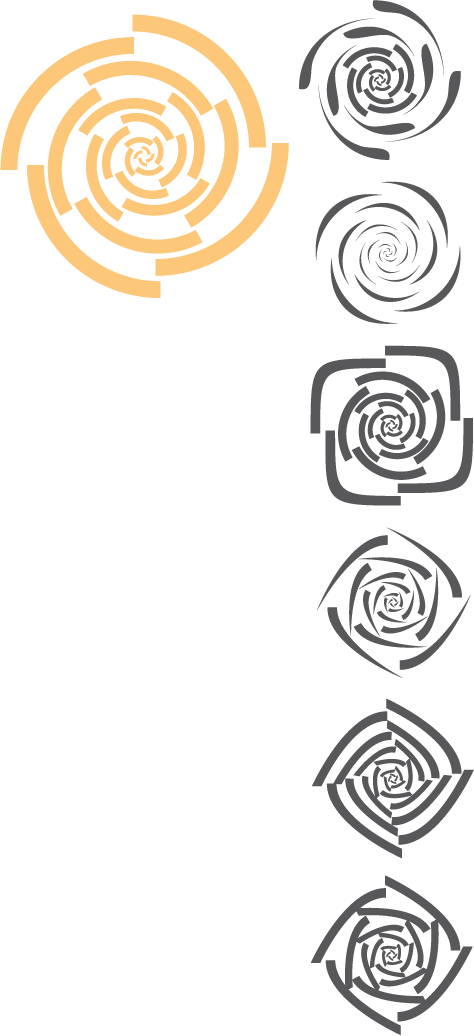Newsletter #2
 We’re deep in the second week of our first prototype! This week we focused on solving the problems we have at hand. Our “Scales” idea has taken an initial shape and we ordered materials and components so that we can begin fabricating a scale model next week. We’ve staggered our schedule for this first prototype because our first two ideas, the Scales and the Jars, share technology between them. By leveraging that, we’ve extended our timeline for the Scales project by one week in order to finalize our form factor and develop fabrication prototypes. With overlapping time, Jason can begin working on the technology for the Jars project. Elwin researched how we could overcome the technical barrier of powering a large array of LEDs while Anisha concepted several visual styles for the LED panels, which you can see to the right. This will allow for us to establish a pipeline, receive our ordered materials and components, and build a rapport with fabrication sites within Carnegie Mellon University.
We’re deep in the second week of our first prototype! This week we focused on solving the problems we have at hand. Our “Scales” idea has taken an initial shape and we ordered materials and components so that we can begin fabricating a scale model next week. We’ve staggered our schedule for this first prototype because our first two ideas, the Scales and the Jars, share technology between them. By leveraging that, we’ve extended our timeline for the Scales project by one week in order to finalize our form factor and develop fabrication prototypes. With overlapping time, Jason can begin working on the technology for the Jars project. Elwin researched how we could overcome the technical barrier of powering a large array of LEDs while Anisha concepted several visual styles for the LED panels, which you can see to the right. This will allow for us to establish a pipeline, receive our ordered materials and components, and build a rapport with fabrication sites within Carnegie Mellon University.
Installation in the Building
Communication with everyone inside the ETC building is paramount for us. We want to make sure the faculty and staff are well aware of what we are planning and the logistics that we have set out for ourselves. We scrutinized several locations within the building and proposed eight spaces, from a large multi-purpose room commonly used for classes to high-traffic and low-traffic hallways and meeting spaces for students, that we felt would be viable for our work. In particular, we discussed design considerations like available power or lighting conditions in the space, as well as maintenance considerations like if the space has clearance. The proposal for our requested spaces was well-received, and we are moving forward with the proposed spaces.
Fabrication Collaboration
While the ETC does have its own small woodshop, our project’s fabrication demands some more specialized equipment than our department can provide. Elwin reached out to ArtFab, a fabrication lab in the School of Art, and spoke with Ali Momeni and Fran Flaherty. When we met, they were both open to accommodating for our project goals, and outlined a plan for collaboration between the ArtFab facility and the ETC. Specifically, they are interested in us sharing any knowledge we learn while we use their equipment and for us to document our process for future students. Fran stepped us through their protocol with the laser cutter, and we’ve set a time to start laser cutting our prototypes early next week!
Roles and Responsibilities
Here’s how the roles of our team fit together:
Jason – Technologist
Responsible for coming up with solutions to the team’s technical problems and needs.
Elwin – Industrial Designer
Responsible for mixing design and technology to create engaging interactions and experiences.
Anisha – Material
Responsible for finding innovative materials and construction techniques, as well as figuring out how to integrate them into each experience.
Yotam – Producer
Responsible for the logistics of each installation, and providing insight into the psychology of interaction.
Current Challenges
Our challenge now is to identify at least two locations in which the Scales prototype could be installed. If we plan to install in the classroom, then we need to do a representative test to demonstrate the impact on the space and ensure that its presence will not be a negative experience for those who frequently use the space, like a miniature playtest. For example, if our installation has a blinking light, we can temporarily install a representative blinking light and survey the students and teachers to see if it is distracting them from class. By doing this quick test, we can not only make sure our installation isn’t disruptive to the ETC routine, but also make sure our technology can hold up for a long period of time before we work on final fabrication.
Looking Forward
Our set deadline for the Scales project is swiftly approaching, especially considering we’ve already stretched our time. We are on a tight schedule to produce both concept art and scale models to demonstrate how the installation will integrate with the space. Our goal is to prototype four ideas by halves, and then select two for installation over Spring Break. We also have time set aside next week to discuss how we can incorporate innovative materials such as conductive textiles.
Our education in this program has largely revolved around virtual experiences and games. By pursuing this project, we are exploring another avenue of entertainment technology: location-based entertainment (LBE). We are diving into both the design of LBE, ranging from architecture to technology, as well as the process of physical fabrication.
